SUFI MOVEMENT
- In the beginning Sufism developed in Arabia, Iran and modern Afghanistan.
- It was formalised by the end of the 8th century.
- Right from the beginning there was a hiatus between the ulemas and the mystics.
- The latter claimed to be delving into the interior of religion, which depended on the heart.
- The Sufi and Bhakti traditions are opposed to external ritualism of prayer.
- The Sufis aim for a direct relationship with God and thus their basic features incorporate strands from various sources including Hinduism.
- It was a liberal reform movement within Islam which spread into India in the eleventh century.
- Sufism stressed the elements of devotion and love as a means of realization of God.
- It recommended a Pir/Murshid/Shaikh or spiritual guru to enhance spiritual development.
- It also emphasized on meditation, musical performances (Sama), fasting, charity and ascetic practices.
- Sufi silsilas were divided into two categories Ba-shara who followed Islamic tenets and Be-shara who did not believe in Sharia.
- Abul Fazl talks about 14 Sufi orders in Ain-e-Akbari.
BE-SHARA
- Many mystics observed celibacy, ignored rituals and took extreme forms of asceticism.
- They deliberately defied sharia.
- Examples: Qalandars, Madaris, Malangs, Haidaris.
BA-SHARA
- Chishti
- Suhrawardi
- Naqshbandi
- Qadiri
- Firdausi
SOME IMPORTANT TERMS
- Murid : Disciple
- Vali : Sufi Heir
- Malfuzat : Compilation of Sufi ideas and speeches
- Maktubat : Compilation of Sufi letters
- Khanqah : Residence of Sufis
- Vilayat : Academic field away from political influence. (This idea was enhanced by the Chishti’s)
- Khalifa : successor of the Pir
- Ziayarat : Pilgrimage to the grave of the Pir
SUFI LITERATURE
- Treatises or manuals dealing with Sufi thought and practices – The Kashf-ul-Mahjub of Al Hujwiri is an example of this genre. It enables historians to see how traditions outside the sub-continent influenced Sufi thought in India.
- Malfuzat (Conversations of the Sufi saints): Malfuzats were compiled by different Sufi Silsilahs, with the permission of the Shaikhs, these had obvious didactic purposes.
- Amrit Kunda: Text on Hatha Yoga was translated into Persian/Arabic as Hauz- Al-Hayat became very popular under Sufis.
- Yoga Qalandhar was written by Sayyid Murtaza.
- Maktubat (Collections of letters): Letters written by Sufi masters, addressed to their disciples and associates – while these tell us about the Shaikh’s experience of religious truth that he wanted to share with others, they also reflect the life conditions of the recipients and are responses to their aspirations and difficulties, both spiritual and mundane.
- Tazkiras (Biographical accounts of the saints): The most famous Tazkira is the Akhbar-ul-Akhyar of Abdul Haqq Muhaddis Dehlavi. The authors of the Tazkiras often sought to establish the precedence of their own orders and glorify their spiritual genealogies.
- The 12th century Mongol invasion, many Sufis took shelter in India, especially in Multan, Punjab, and Sindh.
- One of the greatest Sufi mystics Maulana Jalaluddin Rumi (1207-1273) was very influenced by Indian folklore and even wrote a poem dedicated to the flute of Krishna. He founded the Maulavi Sufi order in which music and dance were spiritual methods.
Chishti Order
- It started outside India in Herat.
- It is the oldest silsila of India established by Khwaja Muinuddin Chishti (Gharib Nawaz) in Ajmer, who came to India during the reign of Muhammad Ghori in 1192.
- Chishti saints led an austere life and did not accept private property and state assistance.
- Although they are known to accept grants from charitable trust (auqaf) and tax free lands (inam) from sultans on many occasions.
- Iltutmish built Muinuddin Chishti’s dargah at Ajmer.
- Muhammad Bin Tughlaq was the first sultan to visit his shrine.
- Akbar visited his shrine almost 14 times and got a mosque constructed within the dargah.
- Other notable saints of this order were Hamiduddin Nagori, QutubuddinBhaktiyar Kaki, Baba Farid and Nizamuddin Auliya.
- Qutubuddin Bhaktiyar Kaki was contemporary to Iltutmish. His discipleFariduddin Ganj-e-Shankar became the famous Baba Farid.
- Baba Farid is known as the first poet of Punjabi and his ideas are incorporated in Guru Grantha Sahib.
- Nizamuddin Auliya was Baba Farid’s disciple.
- Giyasuddin Tughlaq ordered auliya to leave due to his popularity. ‘Dilli abhi dur hai’.
- Amir Khusrau, the greatest disciple of Nizamuddin Auliya gave a distinct form to Chishti sama by introducing qaul (a hymn sung at the opening or closing of qawwali).
- In South India the foundation of Chishti Silsila was laid by Sheikh Burhanuddin Garib (disciple of Auliya), who lived in Daulatabad.
MAJOR TEACHERS OF THE CHISHTI SILSILA
TEACHER, PLACE OF DARGAH, YEAR OF DEATH
- Shaikh Muinuddin, Ajmer (Rajasthan), 1235
- Khwaja Qutbuddin Bakhtiyar Kaki, Delhi, 1235
- Shaikh Fariduddin Ganj-i Shakar, Ajodhan (Pakistan), 1265
- Shaikh Nizamuddin Auliya, Delhi 1325
- Shaikh Nasiruddin Chiragh-i Dehli, Delhi 1356
Suhrawardi Order:
- It was founded by Shiabuddin Suhrawardi in Baghdad.
- It was brought to India by Bahauddin Zakaria who established this order and a Khanqah in Multan.
- Unlike Chishti saints, they lived a life of luxury and accepted state assistance.
- Zakariya helped Iltutmish against Qubacha and got the title of Sheikh-ul-Islam from him.
Naqshbandi Silsila
- This Silsila was established in India by Khwaja Bahauddin Naqshbandi.
- It was later propagated by his successors, Shiekh Baqi Billah and Sheikh Ahmad Sirhindi (1563 – 1624).
- They practiced silent meditation of the heart, so were called “silent Sufis”.
- The Sufis of this silsila believed that the relationship between man and God was that of the slave and the master, unlike Chistis who believed it to be a relation between a lover and beloved.
- Sufis observed the Shariah law in its purest form and denounced all biddats(innovations in religion).
Naqshbandi Silsila
- They were against the liberal policies of Akbar like granting high status to many non-Muslims, abolishment of jizya and the ban on cow slaughter.
- They also were against sama (religious music) and the practice of pilgrimage to the tombs of saints.
- They did not practice Yoga and pranayama unlike all other sufi orders in India.
- After the death of Sirhindi, the order was represented by two important mystics, each having a different approach.
- Conservative approach under the leadership of Shah Waliullah and liberalapproach under the leadership of Mirza Mazhar Jan-i-Jahan.
Qadri Silsila
- Sheikh Abdul Qadir and his sons, Sheikh Niamatullah, Mukhdum Muhammad Jilani and Miyan Mir established the Qadri silsila during the Mughal rule and this order was popular in Punjab.
- Guru Arjan Dev was the disciple of Miyan Mir.
- Miyan Mir is said to have laid the foundation stone of Golden temple at Amritsar.
- Another famous saint of this order was Shah Badakhshani.
- The Mughal princess Jahanara and her brother Dara were disciples of this silsila.
- Qadris believed in the concept of Wahdat-al-Wajood meaning “Unity of Existence” or “Unity of Being”, i.e. God and his creation are one and similar.
- The saints of this silsila dismissed orthodox elements.
Shattariya order
- Founder: Shah Abdullah Shattari, Jaunpur, Lodi period (death 1485)
- Influenced by Suhrawardi, they too lived a luxurious life.
- Famous saint: Muhammad Gaus (1485-1563) also called Qutb.
- Propagated Hindu-Muslim unity.
- Humayun & Tansen influenced by Gaus
- Gaus’s literary works: Jawahar-e-Khamshah & Khalid-e-Mukhajin
- Centres: Bengal, Jaunpur, Deccan
- Famous saints in Burhanpur: Sheikh Isa & Burhanuddin Garib
- Aurangzeb took blessing before succession was from Burhanuddin Garib
Firdausi Order
- Founder in India: Sheikh Badruddin Samarqandi, 13th century
- Famous in Bihar
- Famous saint: Sheikh Sarafuddin Yahiya Muniri who was contemporary to Firoz Tughlaq
- Muniri introduced Maktubat (letters) propagating Wahadat-ul- Wajood
- This order was influenced by Suhrawardis
BHAKTI MOVEMENT
- Bhakti Movement was revivalist movement, responsible for many rites and rituals associated with the worship of God by Hindus, Muslims and Sikhs of Indian subcontinent.
- Bhakti movement appealed to the masses due to its use of regional languages. Bhakti saints condemned the caste system and also gave importance to women.
- Reformist movements strived to change the fundamental system and structures of the society through gradual changes within the existing institutions
- Revivalist movements tended to revive former customs or practices and thus take the society back to the glorious past.
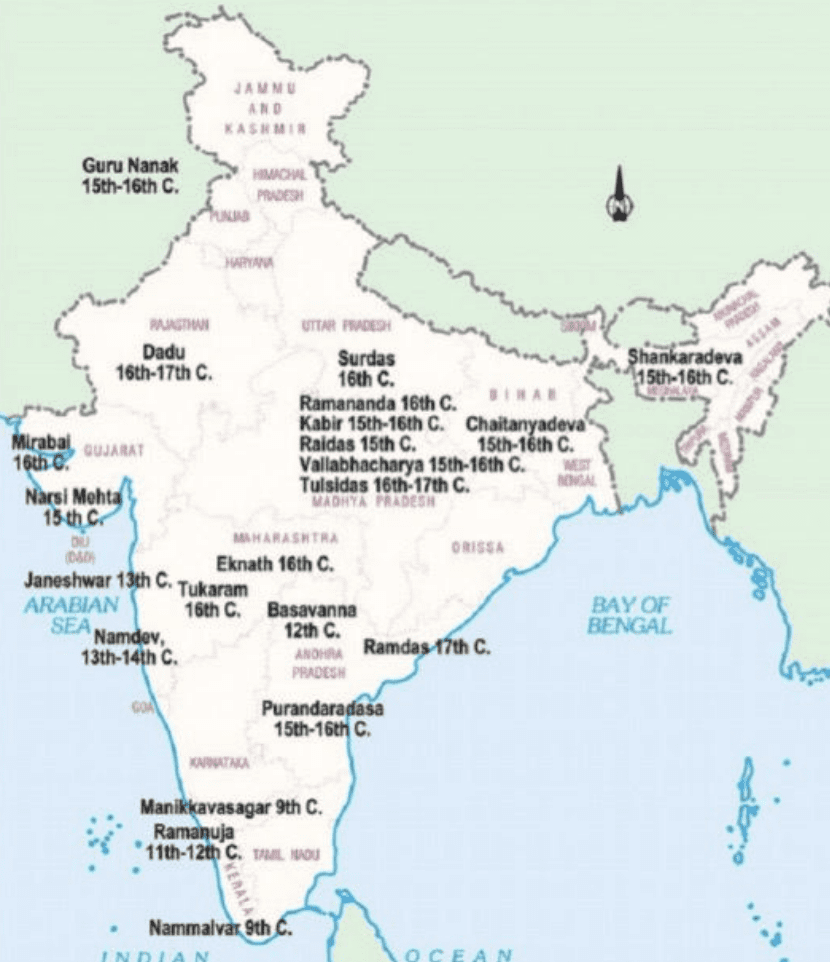
- The Alvars and Nayanars of Tamil Nadu Some of the earliest bhakti movements (c. sixth century) were led by the Alvars (literally, those who are “immersed” in devotion to Vishnu) and Nayanars (literally, leaders who were devotees of Shiva).
- The importance of the traditions of the Alvars and Nayanars was sometimes indicated by the claim that their compositions were as important as the Vedas.
- There were 63 Nayanars, who belonged to different caste backgrounds such as potters, “untouchable” workers, peasants, hunters, soldiers, Brahmanas and chiefs.
- The best known among them were Appar, Sambandar, Sundarar and Manikkavasagar.
- There are two sets of compilations of their songs – Tevaram and Tiruvacakam.
- There were 12 Alvars, who came from equally divergent backgrounds, the best known being Periyalvar, his daughter Andal, Tondaradippodi Alvar and Nammalvar.
- Their songs were compiled in the Divya Prabandham.
- Andal, a woman Alvar, were widely sung (and continue to be sung to date). Andal saw herself as the beloved of Vishnu; her verses express her love for the deity.
- Another woman, Karaikkal Ammaiyar, a devotee of Shiva, adopted the path of extreme asceticism in order to attain goal.
- Tirumurai: Combined Writings of Alvar and Nayanar also called the fifth veda.
Saguna v/s Nirguna
- Saguna represented those poet-saints who composed verses extolling a god with attributes or form. Nirguna represented those poet-saints who extolled god without and beyond all attributes or form. They are also known as Monotheistic Bhakti saints.
- Tulsidas, Chaitanya, Surdas and Meera were the main proponents of Saguna. Nanak and Kabir were the main proponents of Nirguna.
- The Saguna poets preached a religion of surrender and simple faith in a personal god while also supporting idol worship. The Nirguna poet-saints rejected the supremacy of the Brahmins and all conventions based on caste distinctions along with the practice of idolatry.
- Saguna gave importance to the personal experience with god and even though they called their god using different names and titles, yet their god was formless, eternal, non-incarnate and ineffable. On the other hand it seemed that Nirguna ideas were a synthesis of the three traditions; the Vaishnava concept of Bhakti, the Nanpanthi movement and Sufism. Thus, though they had adopted the notion of Bhakti from Vaishnavism, they gave it a Nirguna orientation.
SIMILARITIES BETWEEN SAGUNA AND NIRGUNA SAINTS
- Both laid stress on a personal relationship with the divine and believed in singular devotion and love for God.
- Both were against the ritual observances as were encouraged by the Brahman priests, and many poet-saints, particularly in northern regions, were of low caste lineages.
- Both used the vernacular or regional languages of the masses, as opposed to the sacred language of Sanskrit of the elite priests.
- This helped them to transmit their ideas among the various lower classes.
- The Nathpanthis, Sidhacharas and Yogis questioned the authority of Vedas, criticized rituals and social order and used local language to win support.
- They condemned idolatry and preached monotheism.
- They advocated salvation through meditation.
Shankaracharya (c. 788 – 820 CE)
- He was born at Kaladi in Kerala and became a saint at the age of 5
- He was the disciple of Govindacharya
- He is credited with the doctrine of Advaita Vedanta
- In order to preach and protect the dharma, he founded Ashramas/mathas at Sringeri in Karnataka, Dwarak in Gujarat, Puri in Odisha and Badrinath in UP.
- He wrote commentaries on Brahmasutras.
- His popular works include Vivekachudamani, Saundaryalahari, Bhajagovindam, Shivananda Lahari
- The followers of Shankaracharya are called as Smratas
Shankaracharya and Advaita
- This doctrine is based on the concept that the higher or true Self is identical to Brahman, the Absolute Reality.
- In Advaita Vedanta, Jnana yoga is the path of knowledge to Moksha, or liberation from the cycle of life, death and rebirth.
- This doctrine also believes that Moksha can be achieved in this life (Jivanmukthi) in contrast to other Indian philosophies that emphasize videhamukti, or Moksha after death
- Advaita influenced and was influenced by various traditions and texts of Hindu philosophies such as Samkhya, Yoga, Nyaya, other sub-schools of Vedanta, Vaishnavism, Shaivism, the Puranas, the Agamas.
- Shankaracharya revived Hinduism and posed a challenge to Jainism and Buddhism.
RAMANUJA (11TH – 12TH CENTURY)
- He was born in Preambadur, Tamil Nadu and had influence in Kanchi and Shrirangam.
- He was a Vaishnavite saint who believed in idol worship.
- He preached Visishtadvaita and emphasized on Bhakti over knowledge to attain God.
- According to him the best means of attaining salvation was through intense devotion to Vishnu
- Ramanuja advocated prabattimarga or the path of self-surrender to God.
- He invited downtrodden people to Vaishnavism and advocated salvation by Bhakti.
- He authored Sribhashya, Vedanta Dipa, Gita Bhasya and Vedantasara.
NIMABARKA (12TH CENTURY)
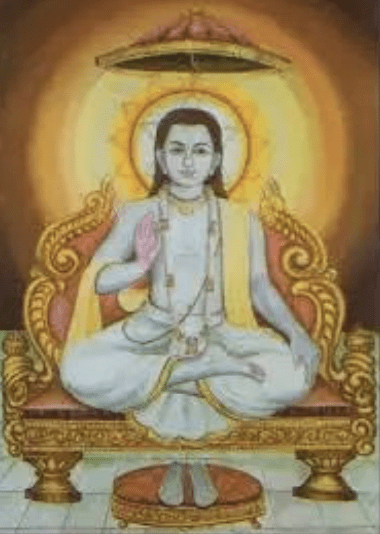
- He was a Vaishnavite saint and believed in the philosophy of dualism or Dvaita (creator is different from creation).
- He worshipped Radha-Krishna and established his ashram in Vrindavana.
- He also founded the Sanak Sampradaya.
BASAVA (12TH CENTURY)
- The 12th century rise of Virashaivas or Lingayats in Karnataka who worshipped Shiva in his manifestation as a linga. They did not believe in the theory of rebirth, rejected caste hierarchy and advocated widow remarriage.
- Basava was the founder of Lingayat sect which is a Shaivite movement.
- He was the prime minister during the reign of Kalachuri dynasty king Bijjala (I) in Karnataka.
- He advocated equality of all human beings, irrespective of caste and that all forms of manual labour are equally important.
- Anubhav Mantapa: It was the first parliament in history of mankind. Proceedings of Anubhava Mantapa are recorded in the form of VachanaLiterature.
Madhvacharya(12th – 13th cen)
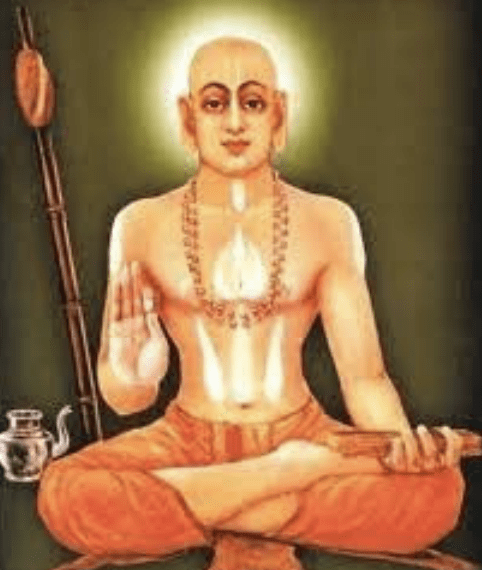
- He was a Vaishnavite and believed in dualism (dvaita).
- He established Brahma Samapradaya.
- He founded the Dvaita School of Vedanta.
- He summarized his doctrinal principles into 10 very brief treatises called the Dasaprakaranas.
RAMANANDA (15TH CENTURY)

- He was the disciple of Ramanuja.
- He worshipped Rama instead of Vishnu.
- He preached in Hindi over Sanskrit and taught people belonging to all varnas.
- Adi Granth contains some of his preaching’s.
- Like other monotheist bhakti saints, he opposed the caste system and chose his disciples from all sections of society, irrespective of caste.
- Kabir and Ravidas were Ramananda’s disciples.
KABIR (15TH – 16TH CENTURY)
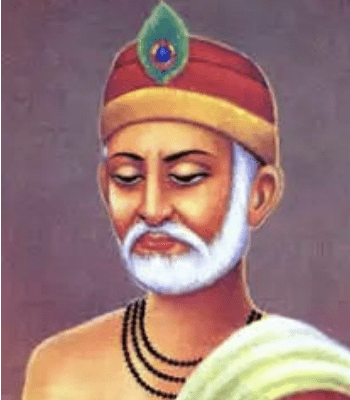
- He preached Hindu Muslim unity and did not believe in idol worship, caste system and untouchability.
- Verses ascribed to Kabir have been compiled in three distinct but overlapping traditions.
- The Kabir Bijak is preserved by the Kabirpanth (the path or sect of Kabir) in Varanasi and elsewhere in Uttar Pradesh; the Kabir Granthavali is associated with the Dadupanth in Rajasthan, and many of his compositions are found in the Adi Granth Sahib.
- All these manuscript compilations were made long after the death of Kabir.
- He was quite familiar with yogic practices and regarded devotion to God as an effective means of salvation.
- He urged his disciples that to attain salvation one must have a pure heart, free from cruelty, hypocrisy, dishonesty and insincerity.
- He considered neither asceticism nor book knowledge important for true knowledge.
- He also did not consider it necessary to abandon the life of a householder for the sake of saintly life.
GURU NANAK (15TH – 16TH CENTURY)
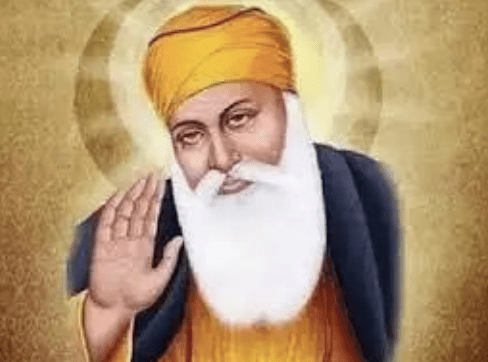
- Most of his teachings are similar to that of Kabir.
- He used to sing with a rabab in his hand and accompanied by a sarangi.
- Baba Guru Nanak advocated a form of nirguna bhakti.
- He firmly repudiated the external practices of the religions he saw around him.
- He rejected sacrifices, ritual baths, image worship, austerities and the scriptures of both Hindus and Muslims.
- For Baba Guru Nanak, the Absolute or “rab” had no gender or form.
- He proposed a simple way to connect to the Divine by remembering and repeating the Divine Name, expressing his ideas through hymns called “shabad ” in Punjabi.
- The fifth preceptor, Guru Arjan , compiled Baba Guru Nanak’s hymns along with those of his four successors and other religious poets like Baba Farid, Ravidas (also known as Raidas) and Kabir in the Adi Granth Sahib.
- In the late seventeenth century the tenth preceptor, Guru Gobind Singh, included the compositions of the ninth guru, Guru Tegh Bahadur, and this scripture was called the Guru Granth Sahib.
- Guru Gobind Singh also laid the foundation of the Khalsa Panth (army of the pure) and defined its five symbols: uncut hair, a dagger, a pair of shorts, a comb and a steel bangle.
- Under him the community got consolidated as a socio-religious and military force.
DADU DAYAL (16TH – 17TH CENTURY)
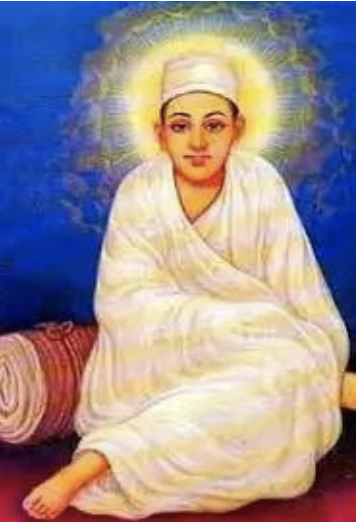
- He was Kabir’s disciple and did not believe in idol worship and caste system.
- His main seat of influence was Rajasthan.
- He believed in leading a householder’s life and was once summoned by Akbar to Fatehpur Sikri for religious discussions.
CHAITANYA MAHAPRABHU (15TH – 16TH CENTURY)
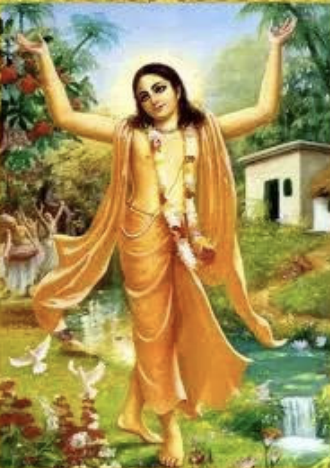
- He was a saint and social reformer of Bengal who popularised the Krishna cult.
- He established Gaudiya Vaishnava dharma in Bengal and believed in advaita or non dualism.
- He was among the few saints who did not oppose idol worship.
- He popularized the medium of Kirtana in Bhakti.
SHANKARDEVA
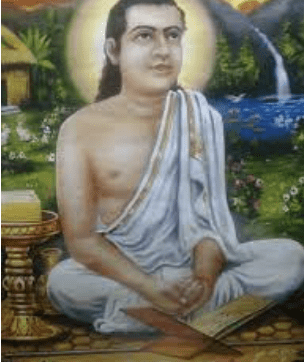
- Sankardeva was a 15th–16th century Assamese polymath; a saint-scholar, poet, playwright, dancer, actor, musician, artist social-religious reformer and a figure of importance.
- He is widely credited with building on past cultural relics and devising: New forms of music (Borgeet), Theatrical performance (Ankia Naat, Bhaona), Dance (Sattriya), Literary language (Brajavali)
- He has left extensive literary trans-created scriptures (Bhagavat of Sankardev), poetry and theological works written in Sanskrit, Assamese and Brajavali.
- The Bhagavatic religious movement: he started, Ekasarana Dharma and also called the Neo-Vaishnavite movement, influenced two medieval kingdoms – Koch and the Ahom kingdom.
- His influence spread even to some kingdoms as the MatakKingdom founded by Bharat Singha, and consolidated by Sarbananda Singha in the latter 18th century endorsed his teachings.
- The assembly of devotees he initiated evolved over time into monastic centers called Sattras, which continue to be important socio-religious institutions in Assam and to a lesser extent in North Bengal even today.
VALLABHACHARYA (15TH – 16TH CENTURY)
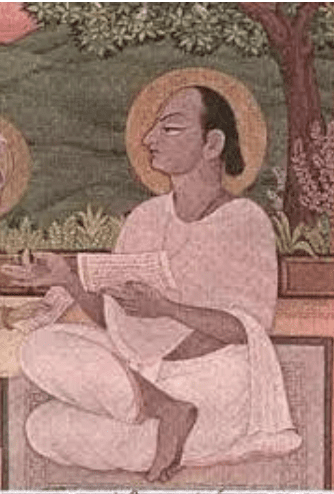
- He established Rudra Sampradyaya and was a contemporary of Chaitanya Mahaprabhu.
- He propagated Pushti Marga and Bhakti Marga to attain Krishna.
- He propounded the philosophy of Shudh Advaita (pure monism) which forms the basis of the pushtimarg devotional practice.
- Surdas was his disciple.
SURDAS (16TH – 17TH CENTURY)

- He was the contemporary of Akbar and Jahangir.
- He was a Krishna devotee and believed in idol worship.
- His major composition Sur Sagar was completed during Jahangir’s reign.
TULSIDAS (16TH – 17TH CENTURY)
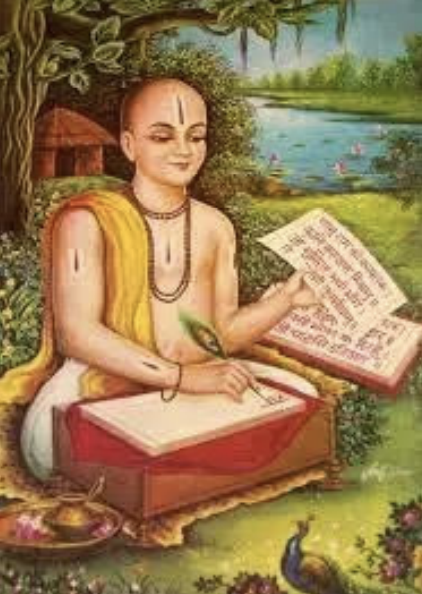
- He was the contemporary of Akbar and wrote Ramacharitamanas in Awadhi language.
- His other compositions include Dohavali, Gitavali and Kavitavali.
THE BHAKTI MOVEMENT IN MAHARASHTRA
- The Bhakti movement in Maharashtra centred around the shrine of Vithoba or Vitthal, the residing deity of Pandharpur, who was considered the manifestation of Krishna.
- This movement is also known as the Pandharpur movement and it influenced the social and cultural developments in Maharashtra.
- For instance, it led to the development of Marathi literature, elevated the status of women, helped in breaking caste distinctions, etc.
- In Maharashtra, the Bhakti movement drew its inspiration from the Bhagavata Purana and the Shiva Nathpanthis.
The Bhakti movement is divided into two sects:
- Varakaris – The mild devotees of God Vitthala of Pandharpur, who are more emotional, theoretical and abstract in their viewpoint.
- Dharakaris – The heroic followers of the cult of Ramadasa, the devotee of God Rama, who are more rational, concrete and practical in their thoughts.
However, the realization of God as the highest end of human life is a common aim of both. The great saints belonging to the Vithoba cult were Jnaneswar/Jnanadeva, Tukaram and Namdeva.
Jnaneswar or Jnanadeva ( c. 1275 – 1296 CE)
- A 13th-century mystical poet-saint of Maharashtra who wrote a commentary of Bhagavad Gita called Jnaneswari which served as a foundation of the Bhakti ideology in Maharashtra.
- He was strictly against caste distinctions and believed that the only way to attain God was through Bhakti.
- He also composed “Amritanubhava” (immortal experience), based on the philosophy of the Upanishads and “Haripatha”, a song admiring Hari (Vishnu).
Namadeva (c. 1270 – 1350)
- A Maharashtrian saint, who flourished in the first part of the 14th century. Namadeva was a tailor who is said to have taken to banditry before he became a saint.
- His poetry which was written in Marathi breathes a spirit of intense love and devotion to God.
- He is considered one of the five revered gurus in the Dadupanthtradition within Hinduism, the other four being Dadu, Kabir, Hardas and Ravidas.
- His Abhangas were included in the Guru Granth Sahib.
Sant Eknath (c. 1533 – 1599 CE)
- He was a scholar of Varkari sampradaya and Vaishnavism, the branch of Hinduism that is characterized by devotion to God Vishnu and his incarnations (avatars).
- He translated various Sanskrit texts into Marathi.
- He introduced a new form of Marathi religious song called Bharood.
- He was a family man and emphasized that staying in monasteries or withdrawing from the world are not necessary for leading a religious life.
- He was against caste distinctions and spread the message that there was no distinction in God’s eyes between Brahmin and outcaste or between Hindu and Muslim.
Tukaram (c. 1608 – 1650 CE)
- A 17th-century poet-saint who was a contemporary of Maratha ruler Shivaji Maharaj and saints like Eknath and Ramdas.
- His poetry was devoted to Vithoba or Vitthala, an avatar of the Hindu God, Vishnu.
- He is known for his Abangas (dohas) in Marathi which are a rich heritage of the Gatha – devotional poetry and was also responsible for creating a background for Maratha nationalism (Parmaratha).
- He laid emphasis on community-based worship with spiritual songs called Kirtans.
Ramdas (c. 1608 – 1681 CE)
- He was a renowned spiritual Guru and has contributed to building the Maratha empire under Shivaji.
- He wrote Dasabhoda, a treatise on the Advaita Vedanta in the Marathi language.
- His other works are Karunashtaken, Janasvabhavagosanvi and Manache Sloka.
- He was strictly against caste distinctions and encouraged women to take part in religious work.